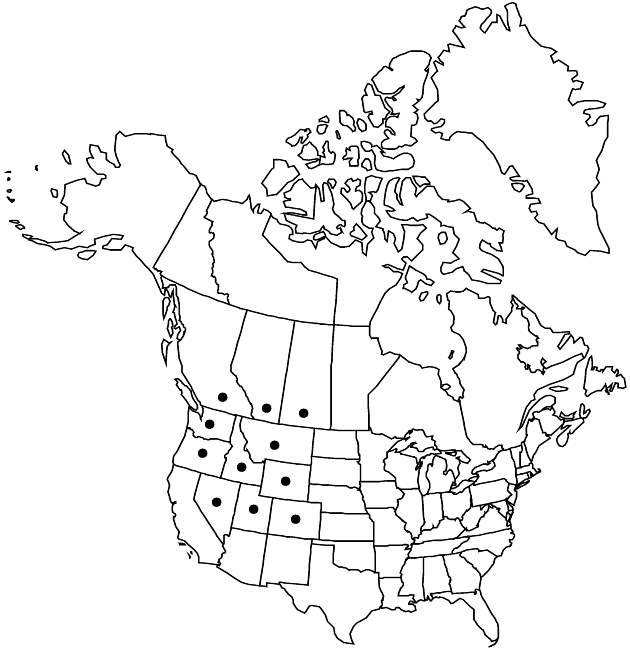Difference between revisions of "Antennaria anaphaloides"
Mem. New York Bot. Gard. 1: 409. 1900.
FNA>Volume Importer |
imported>Volume Importer |
||
| (6 intermediate revisions by 2 users not shown) | |||
| Line 8: | Line 8: | ||
}} | }} | ||
|common_names=Pearly or handsome or tall pussytoes | |common_names=Pearly or handsome or tall pussytoes | ||
| + | |special_status={{Treatment/ID/Special_status | ||
| + | |code=E | ||
| + | |label=Endemic | ||
| + | }} | ||
|basionyms= | |basionyms= | ||
|synonyms={{Treatment/ID/Synonym | |synonyms={{Treatment/ID/Synonym | ||
|name=Antennaria anaphaloides var. straminea | |name=Antennaria anaphaloides var. straminea | ||
|authority=B. Boivin | |authority=B. Boivin | ||
| − | }}{{Treatment/ID/Synonym | + | |rank=variety |
| + | }} {{Treatment/ID/Synonym | ||
|name=Antennaria pulcherrima subsp. anaphaloides | |name=Antennaria pulcherrima subsp. anaphaloides | ||
|authority=(Rydberg) W. A. Weber | |authority=(Rydberg) W. A. Weber | ||
| − | }}{{Treatment/ID/Synonym | + | |rank=subspecies |
| + | }} {{Treatment/ID/Synonym | ||
|name=Antennaria pulcherrima var. anaphaloides | |name=Antennaria pulcherrima var. anaphaloides | ||
|authority=(Rydberg) G. W. Douglas | |authority=(Rydberg) G. W. Douglas | ||
| + | |rank=variety | ||
}} | }} | ||
|hierarchy=Asteraceae;Asteraceae tribe Gnaphalieae;Antennaria;Antennaria anaphaloides | |hierarchy=Asteraceae;Asteraceae tribe Gnaphalieae;Antennaria;Antennaria anaphaloides | ||
| Line 33: | Line 40: | ||
|elevation=1000–3400 m | |elevation=1000–3400 m | ||
|distribution=Alta.;B.C.;Sask.;Colo.;Idaho;Mont.;Nev.;Oreg.;Utah;Wash.;Wyo. | |distribution=Alta.;B.C.;Sask.;Colo.;Idaho;Mont.;Nev.;Oreg.;Utah;Wash.;Wyo. | ||
| − | |discussion=<p>Antennaria anaphaloides is native to the northern Rocky Mountains and is characterized by whitish phyllaries, each with a black spot at the base. Some morphologic overlap occurs between A. anaphaloides and A. pulcherrima; the two occur in different habitats: A. anaphaloides grows in dry meadows and aspen forest openings; A. pulcherrima is usually found in moist willow thickets along streams (K. M. Urbanska 1983). Antennaria anaphaloides is closely related to the other members of the Pulcherrimae group (R. J. Bayer 1990; Bayer et al. 1996).</p> | + | |discussion=<p><i>Antennaria anaphaloides</i> is native to the northern Rocky Mountains and is characterized by whitish phyllaries, each with a black spot at the base. Some morphologic overlap occurs between <i>A. anaphaloides</i> and <i>A. pulcherrima</i>; the two occur in different habitats: <i>A. anaphaloides</i> grows in dry meadows and aspen forest openings; <i>A. pulcherrima</i> is usually found in moist willow thickets along streams (K. M. Urbanska 1983). <i>Antennaria anaphaloides</i> is closely related to the other members of the Pulcherrimae group (R. J. Bayer 1990; Bayer et al. 1996).</p> |
|tables= | |tables= | ||
|references= | |references= | ||
| Line 42: | Line 49: | ||
-->{{#Taxon: | -->{{#Taxon: | ||
name=Antennaria anaphaloides | name=Antennaria anaphaloides | ||
| − | |||
|authority=Rydberg | |authority=Rydberg | ||
|rank=species | |rank=species | ||
| Line 56: | Line 62: | ||
|publication title=Mem. New York Bot. Gard. | |publication title=Mem. New York Bot. Gard. | ||
|publication year=1900 | |publication year=1900 | ||
| − | |special status= | + | |special status=Endemic |
| − | |source xml=https:// | + | |source xml=https://bitbucket.org/aafc-mbb/fna-data-curation/src/2e0870ddd59836b60bcf96646a41e87ea5a5943a/coarse_grained_fna_xml/V19-20-21/V19_635.xml |
|tribe=Asteraceae tribe Gnaphalieae | |tribe=Asteraceae tribe Gnaphalieae | ||
|genus=Antennaria | |genus=Antennaria | ||
Latest revision as of 20:53, 5 November 2020
Dioecious. Plants 15–35(–50) cm. Stolons none. Basal leaves (ephemeral) 3–5-nerved, narrowly oblanceolate or narrowly elliptic, 25–150(–200) × 4–20(–25) mm, tips mucronate, faces gray-pubescent. Cauline leaves oblanceolate or linear, 10–80 mm, usually flagged. Heads 8–30(–50+) in corymbiform arrays. Involucres: staminate (4–)5–6.5 mm; pistillate 4.5–7 mm. Phyllaries (each with dark brown or blackish spot in middle) distally white or cream (sometimes suffused pink to rose). Corollas: staminate 2.5–4 mm; pistillate 3–4.5 mm. Cypselae 1–1.8 mm, glabrous; pappi: staminate 3–4.5 mm; pistillate 3.5–4.5(–5.5) mm. 2n = 28.
Phenology: Flowering summer.
Habitat: Dry meadows and aspen forest openings
Elevation: 1000–3400 m
Distribution

Alta., B.C., Sask., Colo., Idaho, Mont., Nev., Oreg., Utah, Wash., Wyo.
Discussion
Antennaria anaphaloides is native to the northern Rocky Mountains and is characterized by whitish phyllaries, each with a black spot at the base. Some morphologic overlap occurs between A. anaphaloides and A. pulcherrima; the two occur in different habitats: A. anaphaloides grows in dry meadows and aspen forest openings; A. pulcherrima is usually found in moist willow thickets along streams (K. M. Urbanska 1983). Antennaria anaphaloides is closely related to the other members of the Pulcherrimae group (R. J. Bayer 1990; Bayer et al. 1996).
Selected References
None.